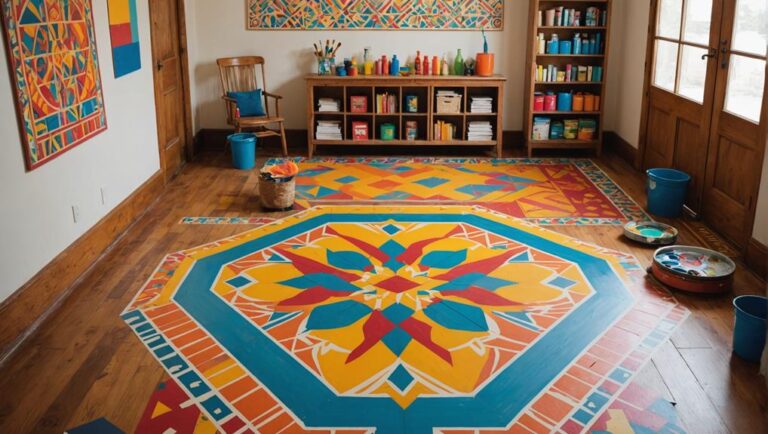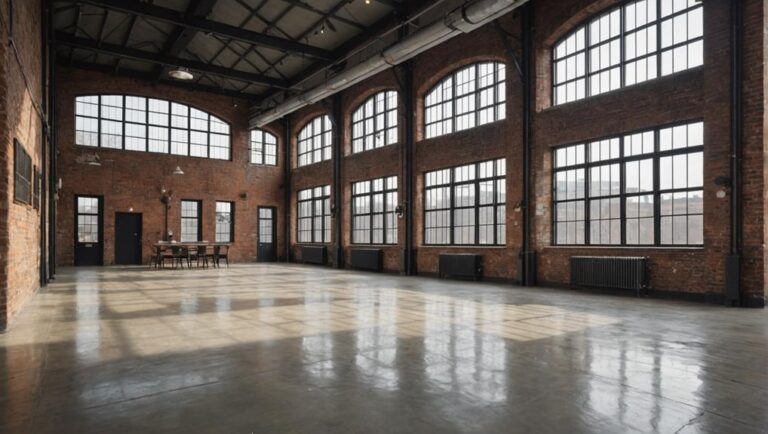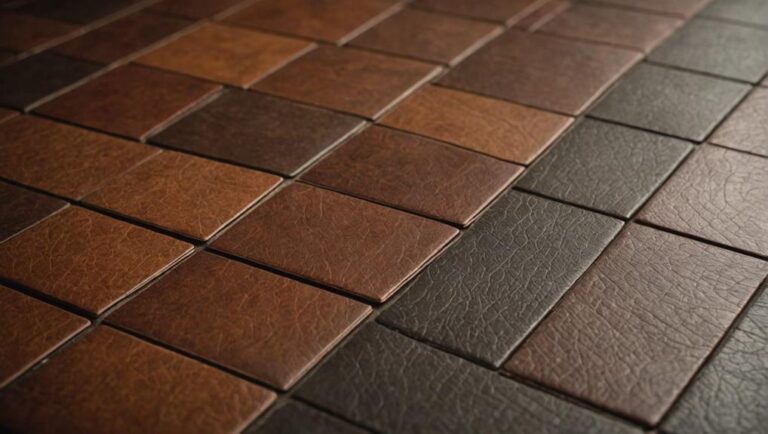To prevent sun damage on outdoor floors, choose UV-resistant materials like composite decking or stone pavers that withstand prolonged exposure. Apply protective coatings, such as epoxy or polyurethane, to seal surfaces and enhance durability. Regular maintenance is essential; sweep debris weekly, inspect for wear, and make certain wooden decks are sealed every few years. Consider shade solutions like pergolas or adjustable umbrellas to minimize direct sunlight, preserving your flooring's integrity. By implementing these strategies, you can considerably extend the lifespan of your outdoor surfaces and their visual appeal. Discover more tips tailored to guarantee ideal care and longevity.
Understanding Sun Damage
When you think about sun damage, it's easy to overlook the impact it can have on outdoor flooring materials. However, understanding the UV radiation effects is vital for guaranteeing the long-term durability of your flooring. Prolonged exposure to the sun's ultraviolet rays can lead to significant deterioration of various outdoor surfaces, including wood, composite materials, and even certain types of stone.
The UV radiation triggers a chemical breakdown within these materials, causing them to fade, crack, or warp over time. For instance, hardwood can lose its natural oils, leading to brittleness and an increased risk of splintering. Composite decking may lose its color and structural integrity, while certain stones can develop unsightly discoloration or surface erosion.
In addition to cosmetic damage, the long-term durability of your flooring can be compromised. Materials that aren't designed to withstand UV exposure may require more frequent repairs or replacements, ultimately driving up maintenance costs. This not only affects your budget but also poses safety hazards for family and guests, as damaged surfaces can lead to slips and falls.
To protect your investment, it's important to recognize these UV radiation effects early. Regular inspections for signs of wear and applying protective coatings or sealants can help mitigate damage and extend the lifespan of your outdoor flooring. By prioritizing this understanding, you're taking proactive steps to guarantee a safer and more enduring outdoor environment.
Choosing UV-Resistant Materials
Selecting the right materials for your outdoor flooring can greatly reduce the risk of sun damage and assure longevity. When you're considering options, prioritize UV-resistant materials that can stand up to harsh sunlight without fading or deteriorating. Two excellent choices are composite decking and stone pavers.
Composite decking is engineered to resist sun damage effectively. Unlike traditional wood, which can warp and fade under UV exposure, composite materials are made from a blend of recycled wood fibers and plastic. This combination not only enhances durability but also provides a consistent color that won't easily bleach out over time. When choosing composite decking, look for products specifically labeled as UV-resistant; these often contain additives designed to protect against sun damage for years.
On the other hand, stone pavers offer a timeless aesthetic while being naturally resistant to UV rays. Options like granite or slate are particularly resilient, maintaining their color and structural integrity even after prolonged exposure to sunlight. The density of these materials helps prevent fading, and their weight ensures they won't shift or crack under fluctuating temperatures.
Both composite decking and stone pavers allow you to enjoy your outdoor space without the constant worry of sun damage. By investing in these UV-resistant materials, you're not just enhancing the beauty of your outdoor area; you're also providing a safe and durable foundation that can withstand the elements for years to come.
Applying Protective Coatings
Although choosing UV-resistant materials is vital, applying protective coatings can further enhance the longevity of your outdoor floors by providing an additional layer of defense against sun damage. Various coating types, such as sealers, paints, and stains, can be tailored to suit the specific needs of your flooring material, whether it's wood, concrete, or composite.
When selecting a coating, consider UV-blocking additives that can absorb or reflect harmful rays, thereby minimizing fading and deterioration. Epoxy and polyurethane coatings are popular choices for their durability and resistance to weathering. Be certain to read product specifications to guarantee compatibility with your flooring type.
Application techniques play an important role in achieving effective protection. Start by thoroughly cleaning the surface to remove dirt, debris, and any previous coatings. This guarantees proper adhesion. Depending on the coating type, you might use a brush, roller, or sprayer for application. For best results, apply multiple thin coats rather than one thick layer; this reduces the risk of bubbling and provides even coverage.
Don't forget to follow the manufacturer's guidelines regarding drying times and environmental conditions. Ideally, you should apply coatings during mild weather to prevent moisture from interfering with adhesion and curing. By taking these steps, you not only protect your outdoor floors from sun damage but also enhance their aesthetic appeal and safety, providing a beautiful and lasting outdoor space for years to come.
Utilizing Shade Solutions
To effectively protect your outdoor floors from sun damage, incorporating shade solutions is a smart strategy. Not only do they provide immediate relief from the sun's harsh rays, but they also help preserve the integrity of your flooring materials. When evaluating your options, you'll want to explore various umbrella styles and pergola designs that fit your outdoor space.
Here are some shade solutions to evaluate:
- Freestanding Umbrellas: Versatile and easy to move, these can be adjusted to follow the sun throughout the day.
- Cantilever Umbrellas: Offering maximum shade without a central pole, these are perfect for covering larger areas.
- Wooden Pergolas: Aesthetic and sturdy, they can be adorned with climbing plants for added shade and beauty.
- Retractable Awnings: These provide flexibility, allowing you to adjust the amount of sunlight or shade as desired.
- Shade Sails: Modern and stylish, these can be hung in various configurations to create unique shaded areas.
Regular Maintenance Tips
Regularly maintaining your outdoor floors is essential for prolonging their life and preventing sun damage. Start by understanding the specific flooring materials you have; whether it's wood, composite, tile, or concrete, each has distinct maintenance needs. For instance, wooden decks require regular sealing to protect against UV rays and moisture, while tile surfaces might need frequent cleaning to avoid mold and algae buildup.
Consider climate considerations too. In hot, sunny climates, UV rays can cause fading and deterioration more rapidly. You should inspect your floors routinely for signs of wear, such as discoloration or cracking. If you notice any damage, addressing it immediately can prevent further issues. For wooden flooring, a fresh coat of sealant every couple of years can help block harmful rays, while composite materials might need less frequent treatment.
Cleaning is another vital aspect of maintenance. Regularly sweep away debris, as leaves and dirt can trap moisture and accelerate deterioration. Use a gentle detergent mixed with water for deeper cleaning, ensuring you avoid harsh chemicals that may damage your flooring materials.
Lastly, always keep an eye on the surrounding environment. Overhanging branches or nearby structures can create shaded spots that impact the floor's exposure to sunlight unevenly. Trim back any overgrowth to maintain consistent exposure, ensuring your outdoor floors stay resilient and safe for years to come.
Seasonal Care Practices
To effectively safeguard your outdoor floors from sun damage, establishing a regular cleaning schedule is essential. Additionally, applying a protective sealant can greatly enhance durability, while exploring shade installation options will provide immediate relief from harsh sunlight. By incorporating these seasonal care practices, you'll guarantee your outdoor surfaces remain resilient and visually appealing year-round.
Regular Cleaning Schedule
A consistent cleaning schedule is essential for maintaining outdoor floors and preventing sun damage over time. Regular cleaning not only enhances the aesthetic appeal but also extends the lifespan of your outdoor surfaces. By following a structured cleaning frequency, you can markedly reduce wear and tear caused by dirt and UV exposure.
Here's a simple checklist to help you establish an effective cleaning routine:
- Weekly sweeping: Remove debris and dirt to prevent scratches.
- Monthly deep cleaning: Use a power washer or scrubber to eliminate stubborn stains and mildew.
- Seasonal inspections: Assess for any damage or wear and address issues promptly.
- Post-storm clean-up: Clear debris and standing water to prevent mold growth.
- Use appropriate cleaners: Select pH-balanced products suitable for your specific outdoor surfaces.
Protective Sealant Application
After establishing a robust cleaning routine, applying a protective sealant becomes an essential step in safeguarding your outdoor floors from sun damage. Sealant types vary widely, including acrylic, polyurethane, and epoxy, each offering unique benefits. Acrylic sealants are known for their quick-drying properties and UV resistance, while polyurethane provides a more durable finish, ideal for high-traffic areas. Epoxy sealants create a strong bond and are excellent for concrete surfaces.
When it comes to application techniques, preparation is key. Start by ensuring your floors are completely dry and free from debris. Use a roller or sprayer for even coverage, applying the sealant in thin layers. This method prevents pooling and allows for better penetration into the material. Depending on the sealant type, you might need to wait several hours between coats for best results.
Always follow the manufacturer's instructions regarding curing times and reapplication frequency, as these factors greatly influence the efficacy of your protective layer. By incorporating regular sealant application into your seasonal care practices, you'll enhance your outdoor floors' resilience against harmful UV rays, ensuring they remain safe and visually appealing for years to come.
Shade Installation Options
When it comes to protecting your outdoor floors from sun damage, shade installation options can play a pivotal role in reducing UV exposure. By incorporating effective shade solutions, you can greatly extend the lifespan of your flooring materials while ensuring a comfortable outdoor experience.
Here are a few shade installation options to evaluate:
- Pergola Design: A beautifully crafted pergola not only adds aesthetic appeal but also provides partial shade, allowing for air circulation while blocking direct sunlight.
- Retractable Awnings: These awning styles offer flexibility; you can extend them during peak sun hours and retract them when not needed.
- Umbrellas: Portable and easy to set up, outdoor umbrellas can be strategically placed in areas that need immediate sun protection.
- Shade Sails: These stylish fabric structures can be custom-installed to create a unique shading solution that complements your outdoor space.
- Canopy Tents: Ideal for larger areas, canopy tents offer ample shade and can be easily assembled or disassembled as needed.
Frequently Asked Questions
What Types of Plants Provide Effective Shade for Outdoor Flooring?
When considering effective shade for your outdoor flooring, shade trees like oaks and maples can provide significant coverage, helping to keep surfaces cool. Additionally, climbing vines such as wisteria or clematis can be trained to grow over pergolas or trellises, creating a beautiful, shaded area. By strategically planting these options, you're not just enhancing aesthetics; you're also ensuring your flooring's longevity and safety by minimizing sun exposure and heat accumulation.
How Often Should I Reapply Protective Coatings?
You should reapply protective coatings based on the type you choose. For example, water-based sealants typically require reapplication every 1-3 years, while oil-based coatings might last up to 5 years. However, factors like exposure to UV rays and weather conditions can affect this frequency. Regular inspections will help determine if your protective coating is still effective, ensuring your outdoor surfaces remain safe and aesthetically pleasing for years to come.
Are There Specific Times of Day to Avoid Sun Exposure?
Think of the sun as a fierce artist, painting its rays across the sky. To protect yourself from harmful sun exposure, avoid the peak hours between 10 AM and 4 PM when those rays are strongest. During these times, UV radiation is at its highest, increasing the risk of skin damage. Seek shade, wear protective clothing, or use sunscreen to guarantee safety from the sun's relentless brush strokes during these critical hours.
Can Sun Damage Affect Indoor Flooring From Sunlight Through Windows?
Yes, sunlight exposure can definitely affect indoor flooring. Prolonged exposure to direct sunlight can lead to fading, discoloration, and even damage to materials like hardwood or laminate. UV rays can break down the finish, leaving your flooring vulnerable to scratches and wear. To maintain the integrity of your indoor flooring, consider using window treatments or UV-blocking films, especially during peak sunlight hours, to minimize damage and prolong your flooring's lifespan.
What Are the Signs of Early Sun Damage on Outdoor Floors?
When you're inspecting outdoor floors, look for signs of early sun damage. Fading colors are often the first indication, as UV rays can strip away vibrant hues. Additionally, surface cracks may begin to appear, weakening the material and making it prone to further issues. If you notice these signs, it's vital to take action to protect your flooring and guarantee its longevity, as neglecting these issues can lead to more extensive damage over time.




